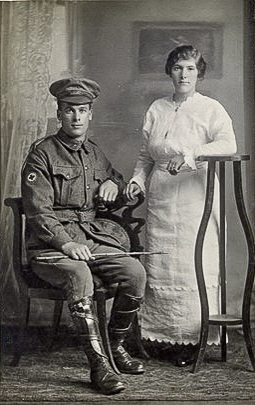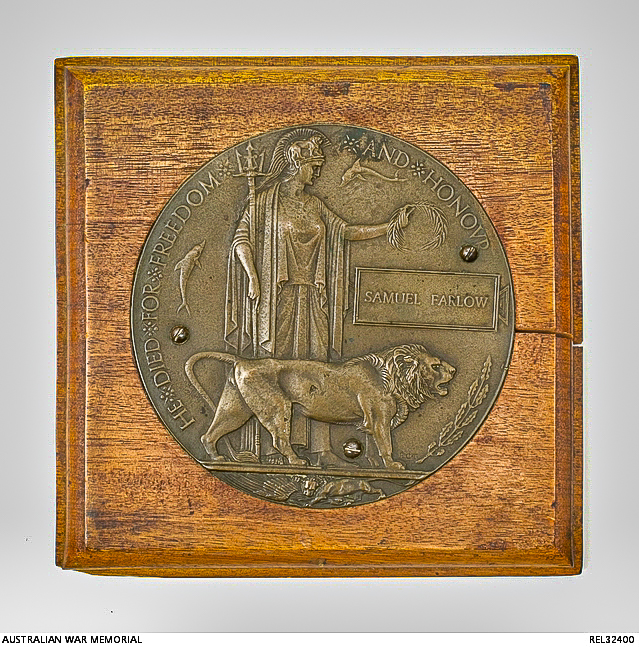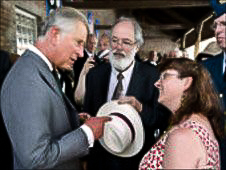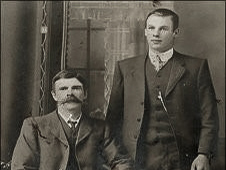
Samuel FARLOW
Eyes grey, Hair brown, Complexion fresh
“One of the Best” – Samuel Farlow
Samuel Farlow, “Sam”, was born in 1875 in Wolverhampton, England to Samuel and Hannah (nee Keeling). Sam grew up with 4 sisters and 1 brother. His mother passed away in 1898 and his father in 1911. The Farlow children must have seen opportunities in Australia. In the late 1880’s, his eldest sister Elizabeth (Lizzie) and her husband Matthew Maloney moved to Australia and settled down about 60km north of Melbourne in the foothills of the Great Dividing Range. Sam’s older sister Sarah Jane moved to Australia in the 1890s and married a Scotsman who had also emigrated, but by 1901 they had returned to Scotland.
Sam was the last to arrive. Before leaving England, Sam worked as a general carter and had been living with his father and his younger sister Clara Webb and her family in Wolverhampton. In 1913 Sam set sail for Australia on the Ship Medic , arriving in Melbourne. On his 1915 enlistment papers he listed his occupation as Stableman and living at Kinglake, a country area north of Melbourne, with his sister Lizzie Maloney and her family.
Off to War
In 1915 Australia raised the maximum age of enlistment from 35 to 40 and Sam answered the call. At the age of 40 years and 1 month, Sam enlisted on 5 July 1915. He had some prior military service in the UK, three years of attachment to the South Staffordshire Regiment Territorials (Volunteer Regiment). He was initially assigned to HQ Details, Pioneer Section, presumably given his age.
His 23 year old nephew Samuel Maloney (Lizzie’s son) also signed up less than a week later. He was assigned to the 14th Field Ambulance. He was residing in Kinglake at the time with his wife Gladys (nee Miller). Gladys was pregnant at the time of her husband’s enlistment, but sadly lost the baby. She and Sam would go on to have two children on his return from war.
Egypt
After a relatively short spell of training in Melbourne, Sam left for Egypt on 10 November and arrived in Suez on 7 December. With the return of soldiers from Gallipoli and the large number of new recruits coming in from Australia, there was a reorganization that saw the AIF expand from two infantry divisions to five. Sam was assigned to the 29th Battalion. While in Egypt, training as well as defence of the Suez Canal continued until mid-June with postings at Ismailia, Tel el Kebir, Ferry Post and Moascar. The troops were reviewed by the Prince of Wales while in Tel el Kebir.
The Western Front
The call to the Western Front came and on 16 June, the 29th boarded the troopship Tunisian in Alexandria, headed to Marseilles, arriving there on the 23rd. They then were on a train to Hazebrouck then on to Steenbeque and by the 26th were encamped in Morbecque, about 30 km from Fleurbaix. The Aussies were well received by the French. In a letter home, James Lang (858), 29th Battalion from Glengarry, Victoria, wrote:
“The French people lined the streets to see us, and gave us a great welcome. Lots of poor women and young girls started crying. No doubt the poor things were thinking of their own dear ones who had gone to the front.”
On 1 July the 29th moved back to Hazebrouck. Gas masks were now included in their training for the possible use of “lachrymatory shells” – tear gas. Training was tough and rugged. One day included a march of 16 miles carrying a 75 lb kit, which only the youngest and fittest could complete. On 9 July they were moved to Erquingham, just outside of Fleurbaix and on the 10th they got their first experience in the trenches, with the “men all in good spirits”. They were back at their billets in Fleurbaix four days later. A gas alarm was sounded on the 15th, but there was no effect on the troops in Fleurbaix.
The Battle of Fromelles
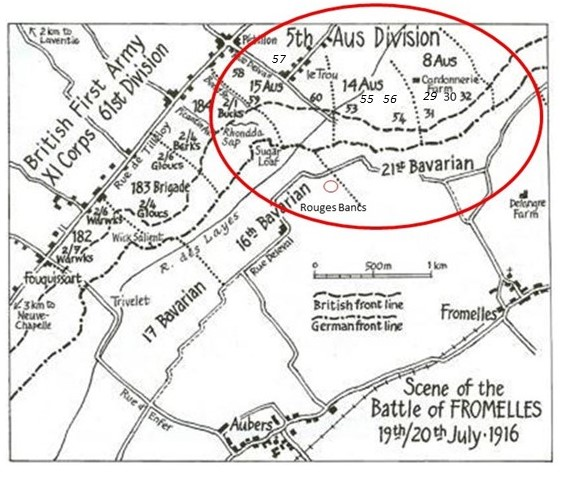
The 29th’s role was to be a ‘fourth’ battalion on the left flank of the attack. With the 30th, they were to provide support for the attacking 31st and 32nd Battalions by digging trenches, carrying supplies/ammunition and to be called in as reserves if needed for the fighting. The original attack was planned for 17 July, but bad weather caused it to be postponed.
On 19 July the 29th were in the rear trenches, ready for the attack. The 32nd’s charge over the parapet began at 5:53 PM and the 31st’s at 5:58 PM. There were machine guns emplacements to their left and directly ahead at Delrangre Farm and there was heavy artillery fire in No-Man’s-Land. The initial assaults were successful and by 6:30 PM the Aussies were in control of the German’s 1st line system, which was described as:
“practically a ditch with from 1 to 2 feet of mud and slush at the bottom”.
By 8:00 PM, A & D Companies began to carry bombs and supplies to the front trenches. The Australians’ left flank had come under heavy bombardment with high explosives and shrapnel. Return bombardment support was provided and the 32nd was told “the trenches were to be held at all costs”.
Source: AWM4 23/49/12, 32nd Battalion War Diaries, July 1916, page 12
At 10:00 PM, additional support was being requested and C and D Companies joined in. Unfortunately, they found that a number of the grenades they were carrying had no fuses. The Germans counter attacked and at 2:00 AM and A and D Companies were drawn into the fighting. B and C Companies were also engaged, continuing to carry supplies and providing cover for soldiers who were retiring from the battle. Fighting continued through the night.
At 4:00 AM the Germans began an attack from the Australian’s left flank, bombing and advancing into the communications trench. Given the Australian advances that had been made earlier, portions of the rearward trench had been left almost empty, which then enabled the Germans to be in a position to surround the advanced soldiers.
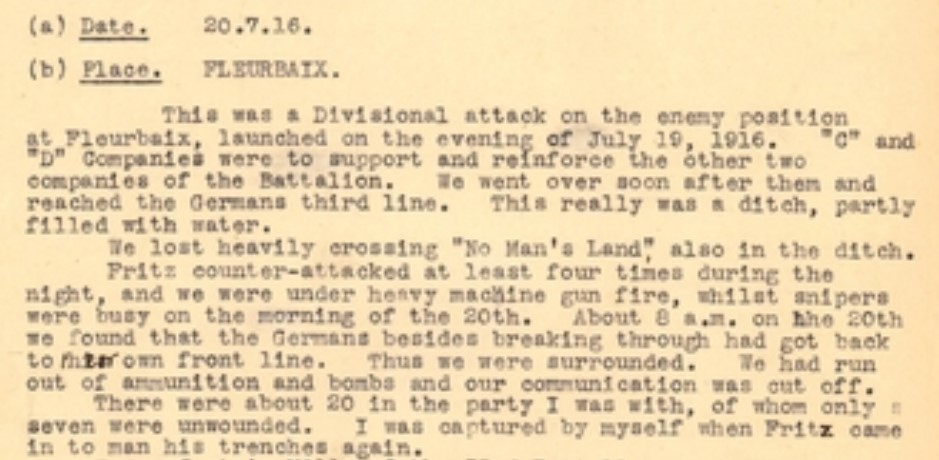
“This was a divisional attack on the enemy position at Fleurbaix, launched on the evening on July 19, 1916. “C” and “D” Companies were to support and reinforce the other two companies of the Battalion. We went over soon after them and reached the Germans third line. This really was a ditch, partly filled with water.”
As the Australian attack had been halted, they became exposed in a salient jutting into the German lines and were quickly enfiladed by German machine guns. “In the end, they basically had to fight their way back to their own lines, 'run for it', or be killed wounded or captured.”
Source 29th Battalion VWMA httpsps://vwma.org.au/explore/units/111
As described by Private Patrick Charles Donovan (222, 29th Battalion), who was a prisoner of war after Fromelles, Sam had survived through the night and was near Patrick after daylight, but he had been wounded. Patrick stated he had tried to shield Sam with sandbags, but he did have to leave him to attend to his duties.
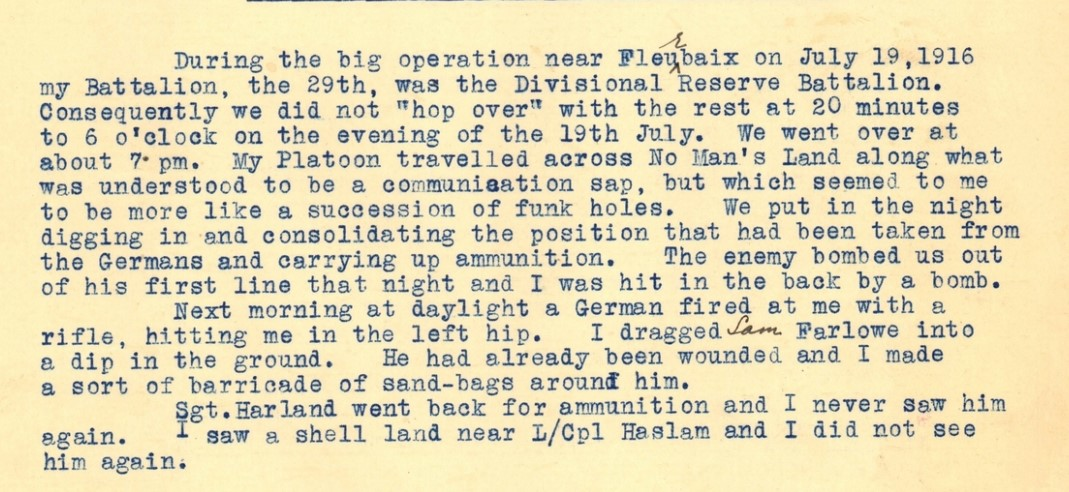
“During the big operation near Fleurbaix on July 19, 1916 my battalion, the 29th, was the Divisional Reserve Battalion. Consequently, we did not “hope over: with the rest…”
“Next morning at daylight a German fired at me with a rifle, hitting me in the left hip. I dragged Sam Farlowe into a dip in the ground. He had already been wounded and I made a sort of barricade of sand-bags around him.”
In the morning the battle was over. The 29th were left to hold the front line and, even though a cease fire was not in effect, they were busily bringing back a large number of wounded during the day and night. The nature of this battle was summed up by Private Jim Cleworth (784) from the 29th:
"The novelty of being a soldier wore off in about five seconds, it was like a bloody butcher's shop".
For a battalion supposed to be in a support role, the initial figures of the impact of the battle on the 29th was 17 soldiers died, 161 were wounded and 68 were missing. Ultimately, 66 soldiers of the 29th Battalion were killed in action or died of wounds from the battle, 37 of whom were unable to be identified…including Sam.
Late and Limited News
For the family back home, the first correspondence received after the battle was at least hopeful when Base Records wrote to Elizabeth on 29 August 1916:
'I regret to inform you that No 80 Pte. S. Farlow, 29th Battalion, has been reported wounded. It is not stated as being serious and in the absence of further reports it is to be assumed that all wounded are progressing satisfactorily.'
There was no further news until late January 1917 when the Army replied to a request from the family. While the response remained positive, the lack of any tangible information – killed or a prisoner - was not a good sign at this late date.
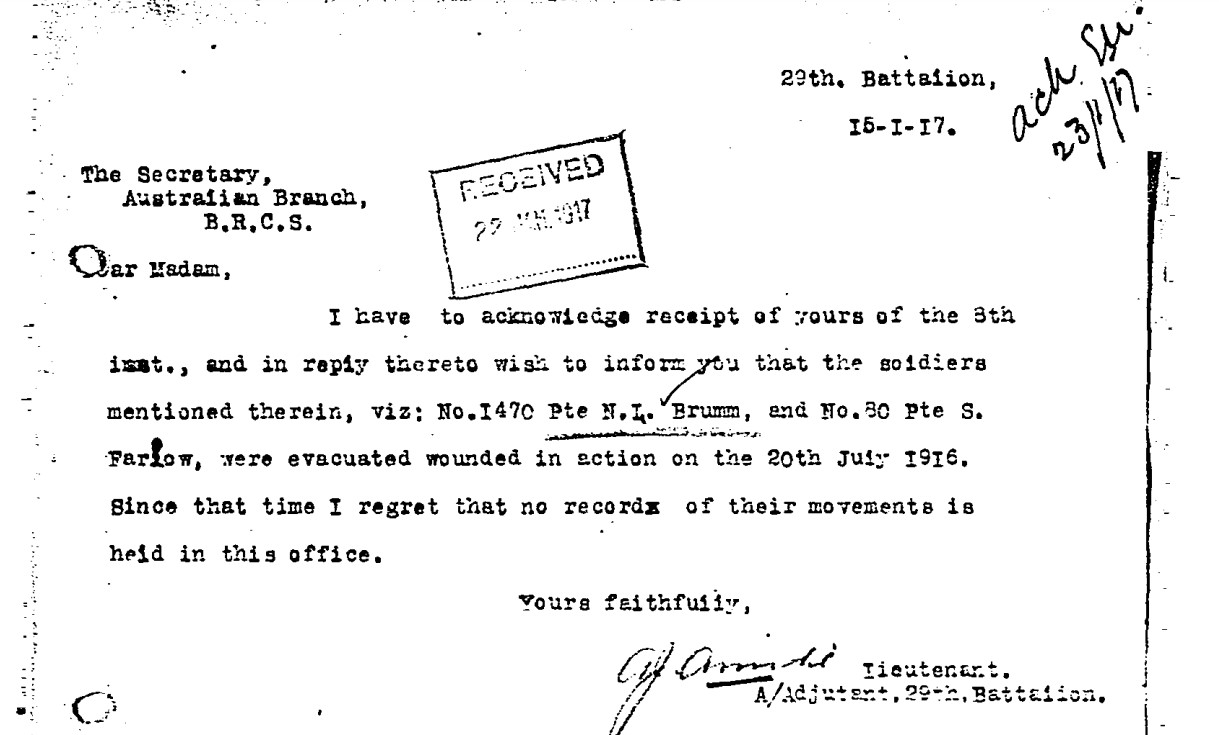
With no further information and torn by anxiety, his niece, Clara Maloney, wrote to the Red Cross in July 1917. She asked for news of him and help in sending correspondence to him if he were a Prisoner of War.
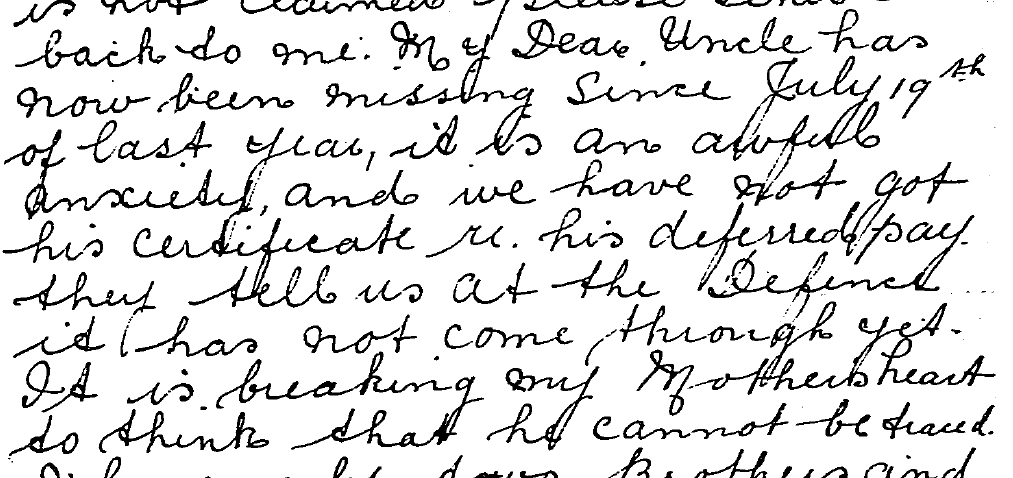
Clara’s letter was responded to, presumably with the sad news. The AIF HQ had actually been informed of Sam’s death several months earlier, but clearly this had not passed this on to the family. Sam was killed in action and his body had been recovered by the Germans.
His name appeared on a German Death List of 4 November 1916. It is not known when this news was provided to the AIF, but in late March 1917 there was a note that his identity disc had been received from the German authorities and that he had been buried in the vicinity of Fleurbaix.
Sam was formally declared as Killed in Action on 18 April 1917 in an ‘enquiry in the field’. Sam’s only personal effects - his safety razor and some blades – were sent to Lizzie in August. His ID disc was sent in November. Curiously, despite the fact that Sam’s older brother George was still alive in Wolverhampton, not to mention her other three sisters, Lizzie had stated that she was his only surviving blood relative, perhaps because she was the only one based in Australia.
Sam’s sister Elizabeth and her family posted a loving tribute to Sam the year following his death after they had been officially notified:
FARLOW. — In loving memory of my dear brother Private Samuel Farlow, of the 29th Battalion, who was killed in action somewhere in France on the 19th July 1916; loving uncle of Mrs J. Hayes, William, Mrs G. Montgomery, Nellie, Samuel (on active service), Clara and Matthew.
The first cable said he was wounded,
Our hearts were sad that day;
The next one said he was missing,
And last of all he was dead.
His King and country called him,
The call was not in vain;
On Australia's roll of honor
You will find dear Sam's name
One of the best
— Inserted by Mr. and Mrs. Maloney and family, Kinglake.
Sam was awarded the 1914-15 Star, the British War Medal and the Victory Medal.
He is commemorated at:
- VC Corner, Panel 1, Fromelles, France,
- The Australian War Memorial Roll of Honour
- The Kangaroo Ground, Shire of Eltham War Memorial Tower
- and at St Peter’s Memorial Church, Kinglake. Sadly, St Peter’s perished in the Black Saturday Fires of 2009, but there is a new memorial.
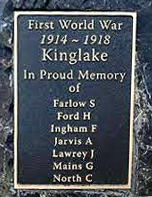
Finding Sam
There were extensive efforts after the War to find missing soldiers.
A witness statement was given to the Red Cross in 1919 that Sam was one of nine soldiers killed on the evening of 19-20 July and buried on 22 July as part of a larger group of twenty or thirty in a grave in a sap near “Water Farm, Pozieres” (this reference to Pozieres was a common mistake of the times relating to French placenames).

The sap (a short covered trench / tunnel) is probably on the Mine Ave end of the trench (marked in blue in the map below) near where the “water farm” is marked.
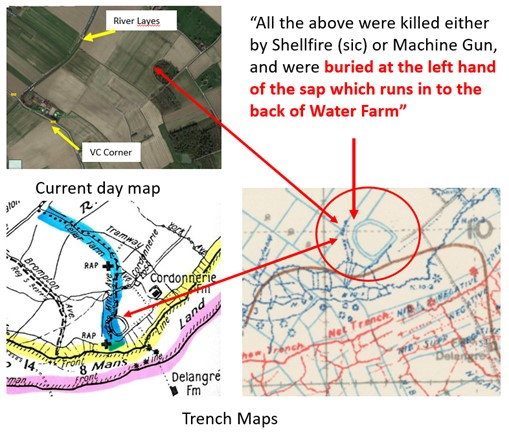
There is also a note on most of their AIF files that they are buried at Fleurbaix, giving a general map reference, sheet 36. A similar note appears on eight of the nine soldiers listed - with the exception being Private Robert Gill who died at the casualty clearing station and is buried at the Bailleul Communal Cemetery Extension.
It would have been chaos in the trenches during the battle and in the immediate aftermath, and it is no wonder records of deaths and burials are often non-existent or contradictory. There are, however, no records of these nine soldiers being found in this vicinity. In 2008, a burial ground was located at Pheasant Wood near Fromelles that contained the bodies of 250 British and Australian soldiers. An extensive identification program has been ongoing and to date (2024) DNA testing has been able to identify 180 of these soldiers, including Sam. He was formally reinterred on July 19th, 2010 with a headstone as a permanent memorial to his sacrifice.
Colin Farlow was at the presentation ceremony in 2010 when Sam was honoured. Colin is a 1st Cousin, 3 times removed who kindly donated DNA to help identify Sam. As a proud “Yam-Yam” himself, Colin was invited to speak at the Fromelles Ceremony at Pheasant Wood in 2010. :
‘Yam-Yams’ are natives of Wolverhampton, England. That’s ‘Yam’ as in ‘Yam a good boy!’ or ‘Yam a hungry lad’ ...... or ........... ‘Yam a brave soldier’. Sam was a “Yam-Yam” who had travelled to Australia for a better life, only to end up almost back in his homeland, lost for nearly 100 years. Colin wonders perhaps we can just hear his voice faintly on the breeze: “I was lost, but now yam found again!”.
The article below published on the BBC Website, outlines the story of finding Sam:
“His great, great niece, Kim Bailey from Wolverhampton visited her long-lost relative's grave at a special cemetery on the site of the pits at Pheasant Wood.
Samel was identified after an Australian researcher asked for DNA, which was provided by Ms Bailey's cousin four times removed, Colin Farlow from Exeter.
Ms Bailey has been researching the family history and discovered that Samuel had gone to Australia in 1913 to join his elder sister. He was recruited into the Australian Imperial Force in 1915, and less than a year later he was killed in battle.
Ms Bailey said it was a tragedy: "It was very, very badly planned. The logistics were terrible. It was the worst day in Australian military history in terms of bloodshed."
She discovered from a book written by Paul Cobb that Samuel had been badly wounded and a Private Donovan had tried to shield him with sandbags, but he died from his injuries. She said he had been reported missing and his niece Clara Maloney wrote to the Red Cross appealing for news of his fate and enclosing a letter for her uncle. It was returned to her.
Ms Bailey and her cousin Colin Farlow attended a special ceremony at the cemetery in Fromelles to pay their respects to Samuel Farlow.
She said Samuel's last resting place was beautiful and poignant: "What they've actually done is buried them in the cemetery exactly where they found them in the pits, so you may have one known soldier next to two unknown soldiers."
She chose a passage from Shropshire war poet Wilfred Owen's poem Send Off for Samuel's gravestone: "Red lips are not so red as stained stones kissed by the English dead."
It was, she said, a fitting tribute: "Although Sam was an Australian, he was quintessentially an Englishman."
Ms Bailey said her farewells on behalf of all of Samuel's family: "I have come to know you through your army records and I am so sad you lost your life.
"I'm so glad that you've been found and you have a final resting place and that I came to say goodbye and represent the whole family with that goodbye. God Bless Sam."
Samuel’s final resting place is known and honoured at last.
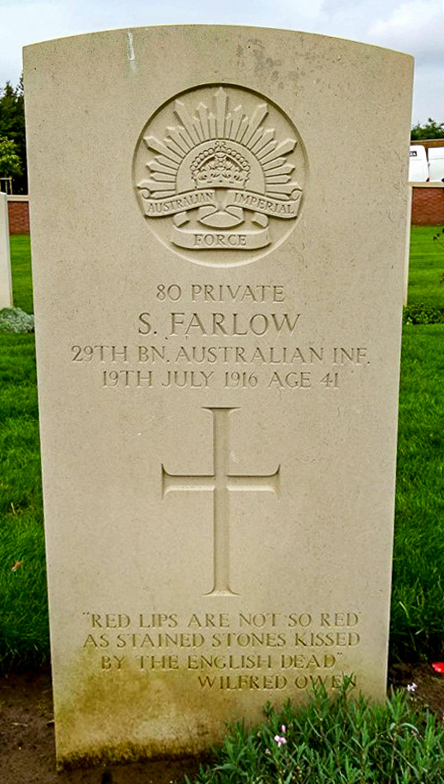
“Red Lips are not so red as stained stones kissed by the English dead” Wildred Owen
Still More to be Found?
Despite being identified as being buried in the sap, four of these nine men - Ernest Wilkin, Frederick Parry, Samuel Farlow and Norman Brumm – were identified in 2010 as being buried in the Pheasant Wood Cemetery! Was the original grave disturbed by shelling or otherwise re-opened necessitating re-burial by the Germans?
With four already identified, are the remaining four (Herbert Westmoreland, Francis Woodcock, Lemuel Batey and James Higgins) still amongst those soldiers now buried at the Pheasant Wood cemetery but unidentified?
Researchers investigated the young men identified as buried in the sap and hope to identify more of the nine by persisting in the search for suitable DNA donors.
The Fromelles Association would love to hear from you

Contacts
(Contact: royce@fromelles.info or geoffrey@fromelles.info).
(Contact: army.uwc@defence.gov.au or phone 1800 019 090).
Donations
If you are able, please contribute to the upkeep of this resource.
(Contact: bill@fromelles.info ).
